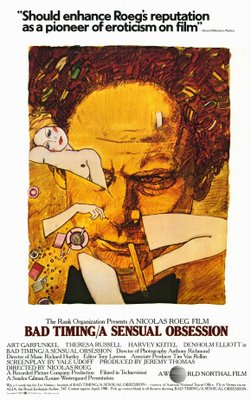 A love it or hate it exercise that’s been described as “a sick movie made by sick people for sick people”…by its own distributor! Needless to say, I’m among those who love it.
A love it or hate it exercise that’s been described as “a sick movie made by sick people for sick people”…by its own distributor! Needless to say, I’m among those who love it.
Actually, the original reaction of Rank Films execs upon viewing the finished cut of BAD TIMING: A SENSUAL OBSESSION was reportedly “Sick…sick…sick!” That was back in 1980, and the film has rarely been seen anywhere since; its original theatrical run was extremely limited, and subsequent screenings have been sporadic.
“Sick…sick…sick!”
In retrospect, it can be seen as marking the end of British director Nicolas Roeg’s most fertile period, which started with PERFORMANCE in 1970 and continued with WALKABOUT (1971), DON’T LOOK NOW (1974) and THE MAN WHO FELL TO EARTH (1976), all bold, experimental and ambitious films. BAD TIMING arguably represents the apotheosis of Roeg’s cinematic obsessions. The film’s minimalist story, with its claustrophobic focus on two less-than-virtuous characters, seems more ideally suited to its director’s tendencies than, say, the sci fi trappings of THE MAN WHO FELL TO EARTH, or PERFORMANCE, which is widely acknowledged to have been largely the vision of its co-director, the late Donald Cammell. BAD TIMING pushes Nicolas Roeg’s stylistic quirks to unheard of extremes, bolstered by the fact that much of the narrative consists of flashbacks, one of Roeg’s favorite modes of cinematic expression.
BAD TIMING pushes Nicolas Roeg’s stylistic quirks to unheard of extremes, bolstered by the fact that much of the narrative consists of flashbacks, one of Roeg’s favorite modes of cinematic expression.
Alex, a stuffy college professor in Vienna, calls an ambulance one night to the apartment of his mistress Milena, who has OD’d. Milena undergoes an emergency tracheotomy to save her life and Alex is interrogated relentlessly by an English detective curious about what transpired before the ambulance was called.
Flashbacks reveal Alex and Milena’s courtship, which from the start was based entirely on sexual obsession. The two are otherwise fundamentally incompatible; Alex feebly attempts to intellectualize his obsession while Milena tries to break away. Her flighty behavior only leads to increasing physical abuse by Alex until the final, fateful night, when Alex rushes to Milena’s apartment to find her zonked out on God-knows-what and rapes her comatose body. Months later, he catches a glimpse of Milena standing on the steps of a NYC hotel, bearing a telltale tracheotomy scar on her neck.
To conclusively detail all this film’s stylistic quirks would be impossible in anything less than novella form. As previously stated, flashbacks are integral to the film’s construction, and come in many forms: as quick two-or-three frame intercuts, as flashbacks within flashbacks and even flashforwards within flashbacks. At one point Alex brutally reprimands Milena and then his mood abruptly changes…and we realize we’re watching the moments preceding the outburst we’ve just witnessed. Disorientation seems to be Roeg’s overriding goal. Note his preference for jarring music cues, in particular the song that plays over the opening shot: a view of a museum painting whose serene mood is broken by Tom Waits at most gravelly. Waits’ voice is in turn cut off by the even more discordant tones of a siren…a perfect lead-in, it turns out, to a singularly bleak story.
Disorientation seems to be Roeg’s overriding goal.
Art Garfunkle’s performance in this film has been widely derided, but I found him quite effective as a weak man who’s in over his head and knows it. Harvey Keitel, as the bizarre, possibly homosexual police inspector, gives a performance so eccentric I’ve never been able to decide whether it’s good or bad. As for Theresa Russell, this is certainly her finest work ever, proving that she really could act once upon a time (an ability she seems to have lost in more recent films like WHORE and KAFKA). She’s not afraid to disrobe, which Roeg has her do constantly in a series of extremely graphic and often disturbing love scenes. This is the only movie I know that intercuts gruesome operation room footage with shots of its main characters having sex.
See Also: Nicolas Roeg: 1928-2018
Vital Statistics
BAD TIMING
Rank Film Productions Ltd.
Director: Nicolas Roeg
Producer: Jeremy Thomas
Screenplay: Yale Udoff
Cinematography: Anthony Richmond
Editor: Tony Lawson
Cast: Art Garfunkle, Theresa Russell, Harvey Keitel, Denholm Elliott, Daniel Massey, Dana Gillespie, William Hootkins, Eugene Lipinski, George Roubicek, Stefan Gryff, Sevilla Delofski, Robert Walker Jr., Gertan Klauber, Ania Marson, Lex Van Delden
